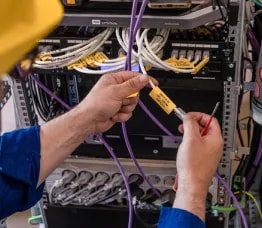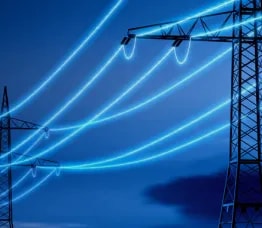Why proven and secure industrial IP/MPLS is the best choice for mission-critical grid modernization

Power utilities everywhere are pursuing modernization initiatives aimed at bringing greater reliability, visibility and sustainability to their energy grids. Many are making IP/MPLS networks a central part of these projects, including Ameren in the US, Fingrid in Finland, Stedin in the Netherlands, Red Electrica in Spain and Transpower in New Zealand.
What’s driving these utilities to adopt IP/MPLS, especially when some utilities still think IP networks aren’t proven or secure like traditional technologies such as leased lines based on copper cables? They’ve realized the concerns about IP/MPLS are unfounded and that they can realize major business benefits by making IP/MPLS a key part of their grid modernization efforts.
A proven foundation for critical networks
IP/MPLS isn’t a new, untested technology. It was established by the Internet Engineering Task Force (IETF) in 1997, when Titanic dominated the box office, the Palm Pilot 1000 helped us organize our lives and we used Netscape Navigator to surf the web on our Windows 95 PCs.
In the 28 years since then, IP/MPLS has been continuously hardened and improved. It has also earned the trust of the world’s top communications service providers (CSPs) as the foundation for mission-critical government and industrial networks.
Securing the world’s largest and most important networks
Security is one of the main reasons CSPs trust IP/MPLS. Deployed in some of the world’s largest and most important networks, IP/MPLS has proven that it can keep data and systems secure. It’s also constantly evolved to keep pace with cyber threats.
As more CSPs have adopted IP/MPLS technology, they have developed new and more robust ways to secure packet networks. Today’s IP/MPLS networks have extensive integrated security features that help utilities defend against cyberthreats, ensure data privacy and comply with regulations and standards such as North American Electric Reliability Corporation – Critical Infrastructure Protection (NERC CIP) and NIS2 in Europe.
Why does this matter? Because if a hacker, saboteur or massive fault causes the grid to go dark, the outage will also knock out the internet, e-commerce, global markets and much more. The power utility industry is already one of the most hardened in terms of its careful analysis of change impact and the actions it takes to ensure safe and reliable power delivery. For utilities that want to monitor their substations with high-definition video cameras or encrypt data generated by the grid, choosing a legacy technology such as TDM SDH/SONET over the more advanced, always-evolving IP/MPLS would be like securing a safe with a manual bike lock instead of the latest biometric, blockchain-based security controls.
A driver of digital transformation for leading utilities
The other advantage of IP/MPLS is that it can support the smart grid applications power utilities want to deploy to modernize their communications, improve grid control and monitoring, and digitally transform transmission and distribution. It provides the flexibility they need to seize opportunities arising from distributed energy resources (DERs), along with the agility needed for enhanced grid automation, augmented reality maintenance and digital twins. With these capabilities, utilities can embrace new grid innovations at speed and scale to optimize asset performance and efficiency while exploring new business models.
One utility that’s reaping the benefits of IP/MPLS is Ameren, which powers 2.5 million electric customers and more than 900,000 natural gas customers in the US states of Missouri and Illinois. Ameren began to roll out a private fiber IP/MPLS network along its transmission lines in 2017, connecting substations, operations centers and other critical locations as part of its digital transformation strategy.
With IP/MPLS, Ameren has improved the quality of its teleprotection application—and boosted overall service quality and reliability—by ensuring substations respond quickly if there is a fault on the line. The IP/MPLS fiber network also extends Ameren’s service, security and management environments into the distribution grid, with the company planning for a private LTE (P-LTE) network to enable advanced automation, Internet of Things and workforce mobility applications. Ameren won the 2020 Utility Technology Council APEX award for its groundbreaking Nokia-powered P-LTE trial.
Many other utilities have embraced IP/MPLS, too. Finland’s Fingrid is using the technology as the backbone of a smart grid to manage the growing adoption of variable DERs such as wind, solar and bio-energy. In the Netherlands, Stedin Groep is working with Nokia to implement an IP/MPLS network that will overcome the bottlenecks it faces when interconnecting DERs with the main grid while also enabling new capabilities such as substation automation.
Spain’s Red Electrica is building out an IP/MPLS network and a new optical transport network to support next-gen IP-based applications, including IoT asset management and distributed energy management. IPTO, the national grid operator of Greece and Transpower, the national grid operator of New Zealand, are making a similar moves, with each rolling out a nationwide IP/MPLS network for substation control, protection and automation.
These companies have seen the future. They’re building modernized energy grids that are intelligent, adaptive and highly secure, with reliable, scalable IP/MPLS technology at the core. With the clear benefits IP/MPLS can offer over TDM SDH/SONET and other legacy technologies, we at Nokia believe it is the best technology to take any power utility into the future. It’s only a matter of time until utilities’ last lingering doubts about it are wiped away completely.
Learn more about IP/MPLS for grid modernization
Website: IP/MPLS or MPLS-TP?
Article: The future grid wavelength: Migrating SDH to Internet Protocol
E-book: Harness the power of IP/MPLS for power grid communications
Website: Power utility modernization








